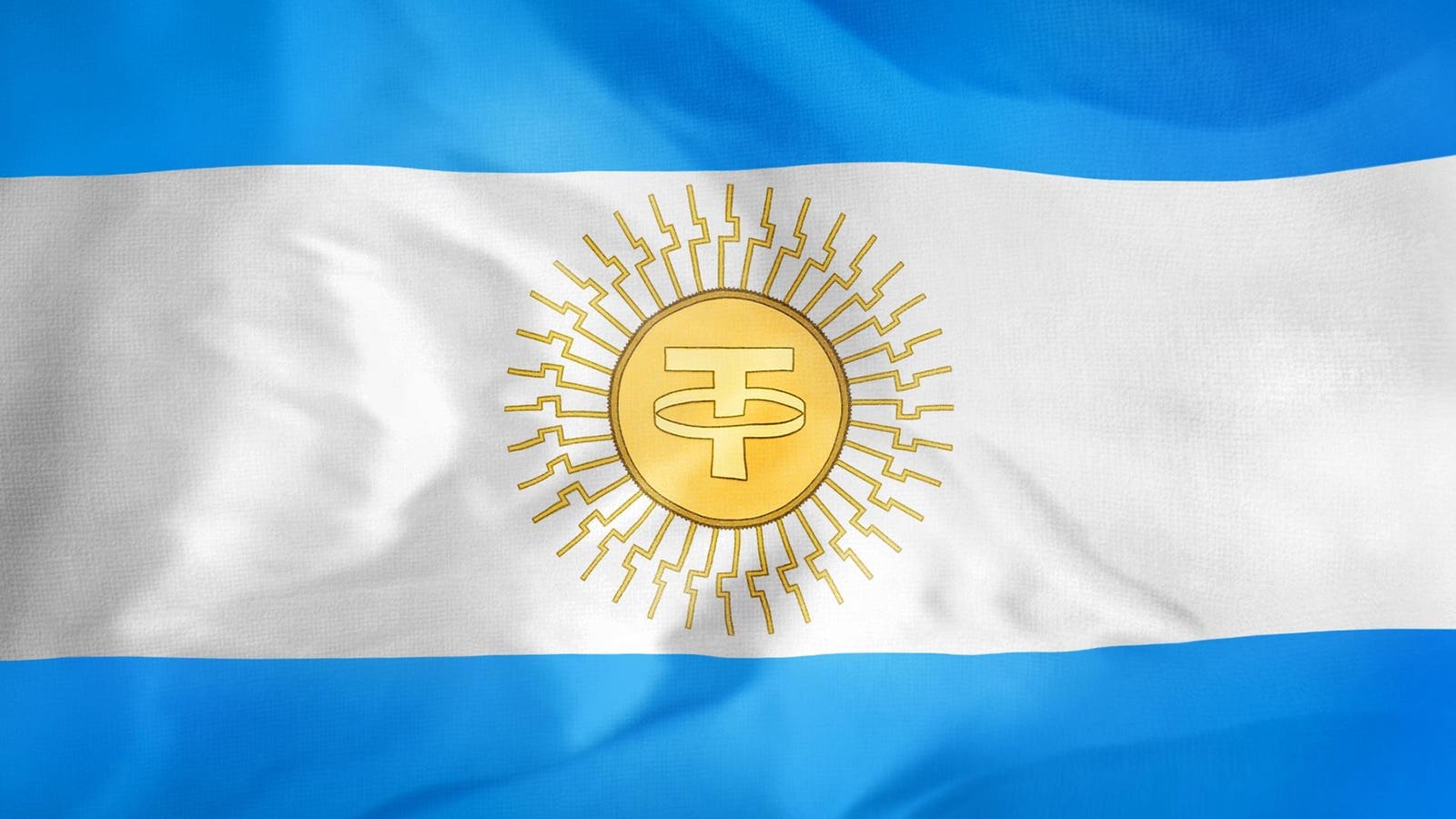News
Why Inflation Battered Argentinians Are Turning To Crypto

Leer en Español
A Forbes analysis found the country, with a 276% inflation rate, has the highest crypto adoption rate in the Western Hemisphere, but little use of the most trustworthy exchanges.
By Javier Paz, Forbes Staff
Inflation has become as much a part of Argentine identity in recent years as asados, its world famous beef barbecues cum social events. In fact, a poignant example of the country’s soaring inflation, which registered a cumulative 276% over the past 12 months, is that the diet of Argentines is changing. Demand for beef, the country’s main food staple, is falling as Argentines resort to less-expensive proteins like pork and chicken. With prices that some forecasters see rising as much as 600% this year, steak is off the table.
But while Argentinians, who tend to eat twice as much beef per capita as hamburger-happy Americans, are just now starting to resort to food substitutes, they have been looking for ways to swap out of their ever-weakening peso for decades. In fact, Argentines have used black-market establishments, nicknamed locally “cuevas”(caves) or “arbolitos” (little trees), to purchase dollars for at least 50 years. The best-known operators appear on Florida Avenue, a main thoroughfare in the capital city of Buenos Aires.
These are not perfect alternatives, as customers can and do get ripped off. Unsanctioned and insecure money exchanges turn pesos to U.S. dollars at sometimes double the government’s published exchange rate. Today, they are only 41% higher than the official 954 pesos to the greenback. Those are not the only risks. According to La Nacion newspaper, one of the two largest dailies, other key risks include a customer being robbed by the trading counterparty or receiving fake currency.
But now a new way of obtaining dollars has taken off: cryptocurrencies. In fact, Argentina’s crypto adoption is higher as a percentage of its global population than any other country in the Western hemisphere. Of 130 million visitors to 55 of the largest exchanges worldwide–a proxy for usage–2.5 million came from Argentina, a Forbes study with SimilarWeb analytics firm data found.
Argentines are not playing the meme coin lottery or trying to strike it rich with the next hot token. Instead, they typically buy and hold tether (USDT), a synthetic dollar with a market value of $112 billion. “Argentina is an anomalous market where many people buy USDT and don’t leave room for much else,” said Maximiliano Hinz, head of Latin America for crypto exchange Bitget. “We don’t see this elsewhere. Argentines buy spot tether and don’t do anything with it.”
But while stablecoins such as tether might seem like a perfect escape hatch from Argentina’s inflationary woes, they come with their own set of risks. The country has not created any regulations to reign in this wild industry, and the world’s most-trustworthy exchanges and marketplaces (as rated by Forbes) are not the choices most widely used by Argentinians.
The country’s new libertarian President, Javier Milei has signaled an openness to the dollarization of Argentina, telling a business gathering on May 17 that the country is headed to a “regime of competing currencies” in which each person will choose which ones to pay and accept for transactions. He anticipated that this would lead to the nation “using the peso less and less, and when it almost stops using it, we will go to a dollarization and to the elimination of the central bank, so that corrupt politicians will not be able to steal by printing money”.
Stablecoins pegged to the U.S. currency are consistent with the dollarization concept, but it’s up to the buyer to find a secure way to buy, hold, and use them. Argentina does not provide meaningful safeguards for crypto users.
Argentina’s crypto adoption is higher as a percentage of its global population than any other country in the Western hemisphere. Of 130 million visitors to 55 of the largest exchanges worldwide, 2.5 million came from Argentina, according to a Forbes study of website data from Similarweb. Additionally, in a report late last year, crypto data analytics firm Chainalysis indicated that Argentina “leads Latin America in raw transaction volume with an estimated $85.4 billion in value received” up to July 2023.
However, their token of choice, USDT, has a complicated history. British-Virgin Island-domiciled Tether guards its internal workings, has never produced an audit and does not disclose which banks it uses. In 2021 the CFTC and the New York Attorney General forced Tether to pay fines of $41 million and $18.5 million respectively for falsely claiming among other things that USDT was backed by U.S. dollars one-for-one. None of these red flags seem to cause customers much concern in a country still reeling from triple-digit inflation.
The risks extend to the exchanges and marketplaces servicing Argentina as well. When Forbes identified the 20 most trustworthy crypto exchanges in the world in May, none of the top five crypto providers in Argentina – Binance, eToro, BingX, HTX and Bitget – were included because of poor internal controls and lack of domestic regulatory oversight. Binance, which has by far the most visited exchange website in the year to March, received more traffic from Argentina than any other nation and does not even have a home-country regulator, let alone a local one.
How risky is doing business with Binance? We know it pleaded guilty to violating U.S. money-laundering rules and to doing business with criminals and alleged terrorists, although the exchange’s $4.3 billion settlement required the acceptance of long-term monitoring to prevent recurrences.
But that is not all. Prior investigations into Binance by Forbes have also revealed that clients can’t always fully rely on balances in their online cryptocurrency wallets since the final word on what they hold comes from the company’s internal books, which are not visible to the public. There have also been incidents when the company has moved funds to collateralize its stablecoins that it issued outside of the exchange. In Binance’s favor, however, it has not fallen into insolvency, has mostly been able to process customer withdrawals, and remains in operation.
It is difficult for ordinary Argentinians, or any other novice investors, to understand and appreciate these risks. Fernando Apud, an Argentine software engineer living in the country’s northern Tucuman province, recently evaluated sites like Cocos Capital, a local firm, and the much larger and sophisticated Binance website. While the sites touted security and convenience as big selling points, he found that even the larger ones like Binance were evasive about disclosing basic information such as whether they were registered to do business in Argentina and the name of the entity that would hold his investments.
When Forbes asked Rose Zimler, with Binance’s Spanish-speaking communications team, about Binance’s status in the country she indicated that the company was “in close contact with authorities” but had not registered in Argentina. She would not give a reason as to why not or whether it intended to do so. She did say that it holds 18 licenses around the world.
Binance is not alone. None of Argentina’s other top crypto exchanges have registered with the Comision Nacional de Valores (CNV), the national securities regulator. They typically suggested to Forbes that they deserve customer trust because of their operating histories. Pablo Monti, a brand ambassador from BingX, on behalf of the exchange’s communications team, declined to specify the nature of the platform’s regulatory compliance in Latin America but told Forbes on May 20: “BingX is further expanding into Argentina and other countries like Turkey and Vietnam as a result of our 6th anniversary as a company.” At eToro, a company spokesman did not address the lack of registration. Still, she said: “As a business which is regulated by financial authorities in multiple jurisdictions around the globe, eToro is committed to being compliant with applicable rules and regulations in all the jurisdictions in which we operate.” Maximiliano Hinz from Bitget, the crypto exchange using the world-famous Argentine soccer star Lionel Messi as brand ambassador, stated: “To the best of my knowledge, there is no licensing requirement in the Latin American countries where Bitget operates.” Finally, HTX, the exchange affiliated with crypto kingpin Justin Sun–did not respond to an email query about its Argentine operations.
Besides the crypto exchanges, Argentinians can tap domestic firms that allow users to buy and spend crypto via prepaid cards, such as Lemon and Buenbit. Still, these also operate in a regulatory gap. In the most recent Chainalysis Latin America report, Lemon Cash’s Head of Compliance Alfonso Martel Seward stated that his firm had roughly two million of the country’s five million crypto users.
Argentinians have had enough of the peso, and who could blame them? Its depreciation has been nothing but trouble for them since the country ended a one-to-one peg to the dollar in January 2002. Years of overspending and debt defaults have plagued the currency since then, bringing the dollar to about 4 pesos a decade after the peg was broken and 64 pesos as the Covid-19 virus made its way to the Americas early in 2020.
While the weakened peso initially gave a boost to trade in the beginning of the century, the benefit withered after 2009 and Argentina has had only two years with a current account surplus since then, according to data from Bloomberg. Over the past 10 years, inflation-adjusted gross domestic product has averaged a 0.1% annual decline, with gains in only four years.
Why else did Argentina struggle? Besides a bloated public sector with 3.5 million employees and lack of commitment to fiscal austerity, external factors such as weather patterns (La Nina) had a major impact on grain exports–the country’s main source of hard currency–last year and this year. Argentina has gone through the worst drought of the last 60 years. “It’s unprecedented that the three crops fail,” stated Julio Calzada, the head of economic research at the country’s main agricultural exchange, referring to soy, corn and wheat. “We are all waiting for it to rain,” Fewer crops translates to fewer dollars, and this fueled higher food prices internally and increased default risk and interest rates. Milei clearly stated in an inauguration day speech on December 10, 2023 that he planned to end previous practices. “This day, we bury decades of failure and senseless fights,” he said. “There is no turning back.” His country had then a 143% annualized inflation rate, a $43 billion trade deficit and a fiscal deficit equivalent to 3.5% of the nation’s gross domestic product. Six months into the job, inflation remains high but the country has had six months of trade surplus and a fiscal surplus of 1.1% of GDP, something that’s gradually restoring billions in hard currency reserves to meet the nation’s more than $45 billion in external debt, most of which is owed to the International Monetary Fund, effectively Argentina’s lender of last resort.
Milei is seeking to reverse policies that seemed destined to harm the Argentine economy. His measures involved laying off tens of thousands of public sector employees, suspending public works, removing energy subsidies, raising taxes and decreasing federal revenue sharing with the provinces.–all very unpopular moves that led to street protests and a sharp reduction to Milei’s fiscal austerity measures, which had limited congressional support. A reduced set of fiscal measures passed in June with the slimmest of margins in the Senate and now heads to the lower chamber where it will enjoy an easier time.
Milei’s conservative tendencies might be the harsh medicine that the country needs to finally move forward, but there is no spoonful of sugar to make the medicine go down easier.
Even if Argentina’s fortunes improve, the previous decades of economic mismanagement mean that the flight to dollars, both paper and increasingly digital, is here to stay. But the government has not taken many steps to protect its citizens.
What crypto regulations exist in Argentina? More than three months ago, the CNV announced a registration requirement for “all those who use web pages, social networks or other means, sending offers/ads to individuals residing in Argentina” and receive user funds “through the use of any technology”. There is no deadline to register. Still, the CNV president Robert E Silva tried to be clear about its impact: “Those who are not registered will not be able to operate in the country.”
This requirement was neither complicated nor onerous to registrants. Yet, none of the 55 crypto firms in the Forbes study, many of which operate in Argentina, registered three months after the rule went into effect on March 25. As of June 20, the public registry shows 48 firms listed, most of which are relatively small businesses that operate locally.
Argentine officials did not respond to repeated requests for comment on the situation.
Registration is a minor step that is clearly not sufficient for the 22nd largest economy in the world at a $633 billion gross domestic product. This is specially true given Argentina’s history of persistent inflation, coups and political turmoil. Bitcoin and the world of digital currencies were born out of the Great Recession , which emanated in the United States in 2008. However, it would have been just as appropriate to have begun in the Andean nation.
MORE FROM FORBES
ForbesThe World’s Most Trustworthy Crypto Exchanges And MarketplacesBy Javier Paz
ForbesWhy Applications To Historically Black Colleges Are SurgingBy Asia AlexanderForbesWhy Top Nuclear Experts And Ex-CIA Brass Joined A High School Grad’s Tiny Fusion StartupBy David JeansForbesMarket Lessons: Price To Book, With 14 Cheap StocksBy Hyunsoo RimForbesHackers Are Now Coming For Your Airline Miles And Hotel PointsBy Jeremy Bogaisky
News
Cryptocurrency Price August 1: Bitcoin Dips Below $65K; Solana, XRP Down Up To 8%

Major cryptocurrencies fell in Thursday trading following the Federal Reserve’s decision to keep its key interest rate unchanged. Overnight, the U.S. Federal Reserve kept its key interest rate at 5.25-5.5% for the eighth consecutive time, as expected, while also signaling the possibility of a rate cut at its next meeting in September. The unanimous decision by the Federal Open Market Committee reflects a continued wait-and-see approach as it monitors inflation trends.
CoinSwitch Markets Desk said: “Bitcoin has fallen below $65,000 after the US Federal Reserve announced it would keep interest rates unchanged. However, with markets now anticipating rate cuts at the next Federal Reserve meeting in September, the outlook for a Bitcoin rally by the end of the year has strengthened.”
Meanwhile, CoinDCX research team said: “The crypto market has plunged after the Fed decision. Tomorrow’s US unemployment rate announcement is expected to induce more volatility, with the ‘actual’ figure coming in higher than the ‘expected’ one, which is positive for cryptocurrencies.”
At 12:21 pm IST, Bitcoin (BTC) was down 3.2% at $64,285, while Ethereum was down nearly 4.5% at $3,313. Meanwhile, the global market cryptocurrency The market capitalization fell 3.6% to around $2.3 trillion in the last 24 hours.
“Bitcoin needs to clear its 200-day EMA at $64,510 to consolidate further. Otherwise, a retest of $62,000 could be in the cards,” said Vikram Subburaj, CEO of Giottus.
Altcoins and meme coins, such as BNB (3%), Solana (8%), XRP (5.7%), Dogecoin (5%), Cardano (4.6%), Avalanche (4.3%), Shiba Inu (3.8%), Polkadot (3.4%), and Chainlink (4%) also saw declines.
The volume of all stablecoins is now $71.64 billion, which is 92.19% of the total cryptocurrency market volume in 24 hours, according to data available on CoinMarketCap. Bitcoin’s dominance is currently 54.99%. BTC volume in the last 24 hours increased by 23.3% to $35.7 billion.
(Disclaimer: Recommendations, suggestions, opinions and views provided by experts are personal. They do not represent the views of the Economic Times)
(You can now subscribe to our ETMarkets WhatsApp Channel)
News
Altcoins WIF, BONK, RUNE, JUP Down 10% While Bitcoin Drops 4%

Altcoins dogwifhat, Bonk, THORChain, and Jupiter have suffered losses of more than 10%, while Bitcoin is down 4% in the last 24 hours.
After a period of relative calm yesterday, July 31, Bitcoin (BTC) price action has seen a drastic change as the cryptocurrency dropped by more than $3,500, bringing its value to $63,300. At the same time, altcoins mirrored this trend, with the total value of liquidated positions rising to nearly $225 million over the course of the day.
Initially, the week started on a positive note for Bitcoin, which reached its highest point since early June, hitting $70,000. However, this peak was short-lived, as it was quickly rejected, leading to a substantial decline, with Bitcoin falling below $65,500.
The cryptocurrency managed to regain some stability, trading comfortably at around $66,800. However, following a Press conference According to Federal Reserve Chairman Jerome Powell, the value of Bitcoin has fallen again to $64,300, down more than 3% in 24 hours.
BTC Price Chart 24 Hours | Source: crypto.news
The recession coincided with a relationship from the New York Times stating that Iran had called for retaliatory measures against Israel following the assassination of Hamas leader Ismail Haniyeh in Tehran, increasing the risk of further conflict in the region.
Meanwhile, on the economic front, the Federal Reserve decided to keep its benchmark interest rates in place, offering little information on a planned September rate cut. Powell also hinted that while no concrete decisions have been made on the September adjustment, there is growing consensus that a rate cut is likely.
Amid Bitcoin’s decline, altcoins have suffered even more significant losses. For example, dogwifhat (Wife) saw a 12.4% drop and (DISGUST) has suffered a 10% drop. Other altcoins such as THORChain (RUNE) also fell by 10%, while Jupiter (JUPITER) and the Ethereum naming service (ENS) decreased by 8% and 9% respectively.
Among the largest-cap cryptocurrencies, the biggest losers are Solana (SOL) with a decrease of 8%, (Exchange rate risk) down 6%, Cardano (ADA) down 4%, and both Ethereum (ETH) and Dogecoin (DOGE) recording a decrease of 4.4%.
Data from CoinGlass indicates that approximately 67,000 traders have been negatively impacted by this increased volatility. BTC positions have seen $61.85 million in liquidations, while ETH positions have faced $61 million. In total, the value of liquidated positions stands at $225.4 million at the time of writing.
News
Riot Platforms Sees 52% Drop in Bitcoin Production in Q2

Bitcoin mining firm Riot Platforms has released its second-quarter financial results, highlighting a decline in cryptocurrency mined due to the recent halving.
Colorado-based Bitcoin (BTC) mining company Riot platforms revealed its second quarter financial results, highlighting a significant reduction in mined cryptocurrencies attributed to the recent halving event that took place in early April.
The company reported total revenue of $70 million for the quarter ended July 31, a decline of 8.7% compared to the same period in 2023. Riot Platforms attributed the revenue decline primarily to a $9.7 million decrease in engineering revenue, which was partially mitigated by a $6 million increase in Bitcoin extraction income.
During the quarter, the company mined 844 BTC, representing a decline of over 50% from Q2 2023, citing the halving event and increasing network difficulty as major factors behind the decline. Riot Platforms reported a net loss of $84.4 million, or $0.32 per share, missing Zacks Research forecast a loss of $0.16 per share.
Halving increases competitive pressure
The Colorado-based firm said the average cost of mining one BTC in the second quarter, including energy credits, rose to $25,327, a remarkable 341% increase from $5,734 per BTC in the same quarter of 2023. Despite this significant increase in production costs, the firm remains optimistic about maintaining competitiveness through recent deals.
For example, following the Recent acquisition Cryptocurrency firm Block Mining, Riot has increased its distributed hash rate forecast from 31 EH/s to 36 EH/s by the end of 2024, while also increasing its 2025 forecast from 40 EH/s to 56 EH/s.
Riot Platforms Hashrate Growth Projections by 2027 | Source: Riot Platforms
Commenting on the company’s financials, Riot CEO Jason Les said that despite the halving, the mining company still managed to achieve “significant operational growth and execution of our long-term strategy.”
“Despite this reduction in production available to all Bitcoin miners, Riot reported $70 million in revenue for the quarter and maintained strong gross margins in our core Bitcoin mining business.”
Jason Les
Following its Q2 financial report, Riot Platforms shares fell 1.74% to $10.19, according to Google Finance data. Meanwhile, the American miner continues to chase Canadian rival Bitfarms, recently acquiring an additional 10.2 million BITF shares, increasing its stake in Bitfarms to 15.9%.
As previously reported by crypto.news, Riot was the first announced a $950 million takeover bid for Bitfarms in late May, arguing that Bitfarms’ founders were not acting in the best interests of all shareholders. They said their proposal was rejected by Bitfarms’ board without substantive engagement.
In response, Bitfarms She said that Riot’s offer “significantly understates” its growth prospects. Bitfarms subsequently implemented a shareholder rights plan, also known as a “poison pill,” to protect its strategic review process from hostile takeover attempts.
News
Aave Price Increases Following Whales Accumulation and V3.1 Launch

Decentralized finance protocol Aave is seeing a significant spike in whale activity as the market looks to recover from the recent crash that pushed most altcoins into key support areas earlier this week.
July 31, Lookonchain shared details indicating that the whales had aggressively accumulated Aave (AAVE) over the past two days. According to the data, whales have withdrawn over 58,848 AAVE worth $6.47 million from exchanges during this period.
In one instance, whale address 0x9af4 withdrew 11,185 AAVE worth $1.23 million from Binance. Meanwhile, another address moved 21,619 AAVE worth over $2.38 million from the exchange and deposited the tokens into Aave.
These withdrawals follow a previous transfer of 26,044 AAVE from whale address 0xd7c5, amounting to over $2.83 million withdrawn from Binance.
AAVE price has surged over 7% in the past 24 hours amid buy-side pressure from these whales. The DeFi token is currently trading around $111 after jumping over 18% in the past week.
Recently, the price of AAVE increased by over 8% after Aave founder Marc Zeller announced a proposed fee change aimed at adopting a buyback program for AAVE tokens.
Aave v3.1 is available
The total value locked in the Aave protocol currently stands at around $22 billion. According to DeFiLlamaApproximately $19.9 billion is on Aave V3, while the V2 chain still holds approximately $1.9 billion in TVL and V1 approximately $14.6 million.
Aave Labs announced Previously, Aave V3.1 was made available on all networks with active Aave V3 instances.
V3.1 features improvements that are intended to improve the overall security of the DeFi protocol. The Aave DAO governance has approved the v3.1 improvements, which also include operational efficiency and usability for the network.
Meanwhile, Aave Labs recently outlined a ambitious roadmap for the projectwith a 2030 vision for Aave V4, among other developments.
-

 Regulation11 months ago
Regulation11 months agoRipple CTO and Cardano founder clash over XRP’s regulatory challenges ⋆ ZyCrypto
-

 Regulation9 months ago
Regulation9 months agoNancy Pelosi Considers Supporting Republican Crypto Bill FIT21 – London Business News
-

 Videos11 months ago
Videos11 months agoCryptocurrency News: Bitcoin, ETH ETF, AI Crypto Rally, AKT, TON & MORE!!
-

 Regulation11 months ago
Regulation11 months agoBitcoin’s future is ‘bleak’ and ripe for regulation, says lead developer
-

 News8 months ago
News8 months agoAave Price Increases Following Whales Accumulation and V3.1 Launch
-

 Regulation8 months ago
Regulation8 months agoSouth Korea Imposes New ‘Monitoring’ Fees on Cryptocurrency Exchanges
-

 Regulation8 months ago
Regulation8 months agoA Blank Sheet for Cryptocurrencies: Kamala Harris’ Regulatory Opportunity
-

 Regulation8 months ago
Regulation8 months agoCryptocurrency Regulations in Slovenia 2024
-

 News11 months ago
News11 months agoThe trader earned $46 million with PEPE after reaching a new ATH
-

 Regulation10 months ago
Regulation10 months agoCrypto needs regulation to thrive: Tyler Cowen
-

 Blockchain11 months ago
Blockchain11 months agoSolana ranks the fastest blockchain in the world, surpassing Ethereum, Polygon ⋆ ZyCrypto
-

 Blockchain10 months ago
Blockchain10 months agoSolana Surpasses Ethereum and Polygon as the Fastest Blockchain ⋆ ZyCrypto















